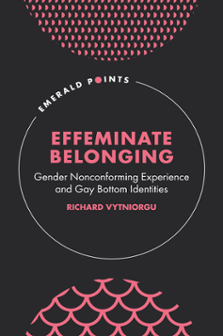
Notes on Research Ethics
ISBN: 978-1-80455-010-6, eISBN: 978-1-80455-009-0
Publication date: 21 June 2024
Citation
Vytniorgu, R. (2024), "Notes on Research Ethics", Effeminate Belonging, Emerald Publishing Limited, Leeds, pp. 19-20. https://doi.org/10.1108/978-1-80455-009-020241016
Publisher
:Emerald Publishing Limited
Copyright © 2024 Richard Vytniorgu. Published under exclusive licence by Emerald Publishing Limited
Not only does this book explore sexually explicit narratives which require sensitive, respectful and attentive reading, but many of them are also created and circulated through social media and online forums. As media scholars have noted, such content can represent an ethical grey area for researchers: should content be attributed to those who produce it? How does a researcher utilise material when the original creators of that content may be unaware that researchers are interested in it?
The fact that such material exists in the public domain is not in itself a sufficient reason to follow ordinary scholarly attribution habits, such as citing quotations against an author's published (user)name. For example, Chapter 5 explores sexual writing and imagery published on social media sites such as Tumblr and Reddit, as well as viewer comments on porn sharing websites. Some of these comments are also controversial in that they cast slurs or criticisms against porn actors on the basis of perceived effeminacy or feminised traits. However, other social media content explored in this book is neither intended to be pornographic nor derogatory, demanding a somewhat modified approach to citation. In light of this, I have made the following decisions about attribution.
Following guidelines by media scholars Fiesler and Proferes, I have chosen to anonymise identifying information when quoting from pornographic social media posts and viewer comments on porn sharing sites (2018, p. 10). This decision is particularly salient in relation to those users who post derogatory comments about porn actors (Brody et al., 2022, p. 4). While I feel it's important and useful to analyse these comments in their original vocabulary and their importance for representing gendered and sexual practices and identities, I am also mindful of not wishing to draw attention to or cause harm to those who are responding to erotic material under a deliberately anonymous guise. I will therefore also not be including URL links to such online content and, where necessary, will also paraphrase or modify posts to avoid them being traced via internet searches (Greenhalgh et al., 2021).
However, I will include URL links to social media posts that are neither pornographic nor derogatory about others, such as those about bottom shaming or stigma associated with being a bottom and/or with being effeminate. This is partly in recognition that these internet posts may still be of use to my readers who want to learn about how LGBTQ+ individuals are conceptualising sexual practices online, thereby following the suggestion by Fiesler and Proferes that ‘publication of user identity should only occur when the benefits of doing so clearly outweigh the potential harms’ (2018, p. 10). I will also include URL links and author names for erotic stories published online, given the genre difference and expectation that fictional stories have an author and that author names can be legitimately pseudonymised.
Finally, I am driven by two overarching considerations. The first is to be as ethically sensitive as possible when handling sexual material, especially by those who circulate and produce such material under online personas and an expectation of anonymity. But I am also mindful of how these users form counterpublics online by producing and sharing sexually explicit material (Warner, 2002), or what Cavalcante describes as a ‘public that caters to the marginalised and disenfranchised’ (Cavalcante, 2017, p. 117). In a book which not only explores different modes of belonging among gender nonconforming males and/or bottoms, but also seeks to use the book as an opportunity to galvanise such belonging for marginalised people, the question of privacy and community is especially potent. I have aimed for an overall contextual approach, considering the specific contexts in which online speech utterances occur, the uses to which they have and might be put, while also considering the inadvertent consequences for counterpublic formation if solicitude for privacy is taken to unnecessary extremes.
- Prelims
- Introduction
- Notes on Terminology
- Notes on Research Ethics
- Part 1 Theories, Perspectives and Sources
- 1 Gender Nonconformity, Effeminacy and Gay Bottom Identities
- 2 Marginalisation and Belonging
- 3 Narratives on the Margins
- Part 2 Readings, Concerns and Directions
- 4 Fem Gay Bottom: Can I Be All Three?
- 5 Fem Bottoms in Practice
- 6 Effeminate Belonging and Sexual Wellbeing
- Conclusion
- About the Author
- Bibliography
- Index